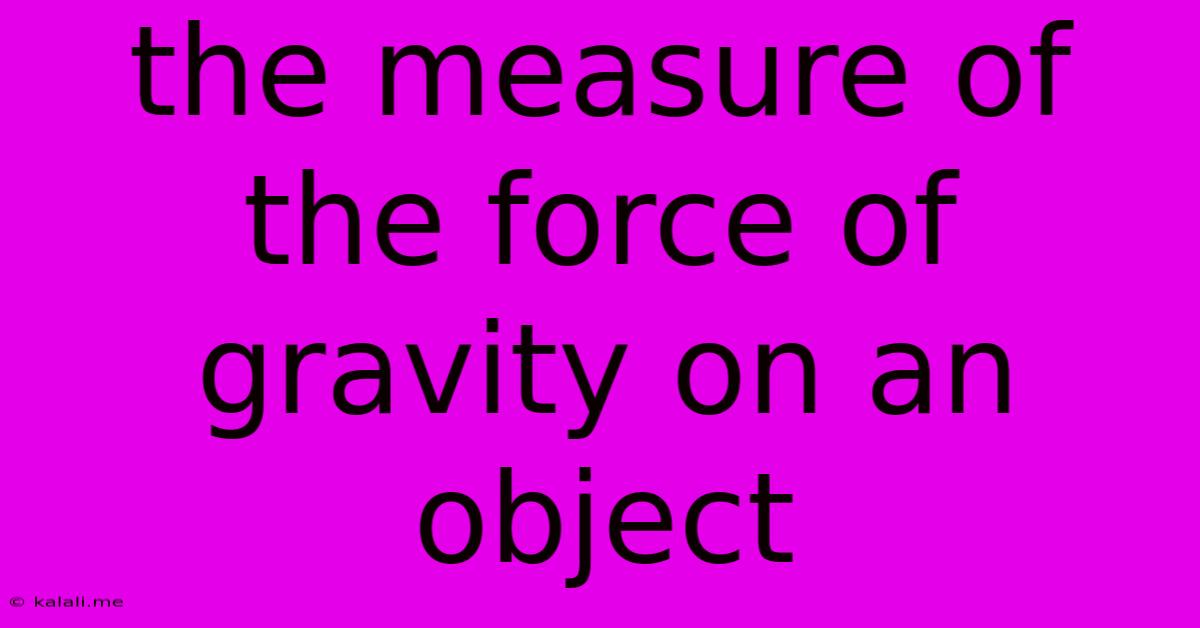The Measure Of The Force Of Gravity On An Object
Kalali
May 09, 2025 · 3 min read

Table of Contents
Understanding the Measure of Gravity's Force on an Object: Weight and Mass
Understanding how gravity affects an object involves grasping the difference between mass and weight. While often used interchangeably in everyday conversation, they represent distinct physical quantities. This article will explore the measurement of gravity's force on an object, focusing on the concept of weight and the factors influencing it.
What is Mass?
Mass is a measure of the amount of matter in an object. It remains constant regardless of the object's location. A kilogram of feathers and a kilogram of iron have the same mass, even though their volumes differ significantly. We typically measure mass using a balance scale, comparing the unknown mass to known standards. The SI unit for mass is the kilogram (kg).
What is Weight?
Weight, unlike mass, is a measure of the gravitational force acting on an object. It's a force, meaning it has both magnitude (strength) and direction (always towards the center of the Earth, or whichever celestial body exerts the dominant gravitational pull). Weight is dependent on both the object's mass and the strength of the gravitational field it's experiencing. Therefore, an object's weight can change depending on its location.
How is Weight Measured?
Weight is typically measured using a spring scale, which measures the force exerted by gravity on the object. The SI unit for weight (which is a force) is the Newton (N). One Newton is approximately the force required to accelerate a 100-gram mass at 1 meter per second squared.
The Formula: Weight = Mass x Gravity
The relationship between weight (W), mass (m), and the acceleration due to gravity (g) is expressed by the simple formula: W = mg.
- W represents the weight in Newtons (N).
- m represents the mass in kilograms (kg).
- g represents the acceleration due to gravity in meters per second squared (m/s²). On Earth, the average value of g is approximately 9.81 m/s². This value can vary slightly depending on location (altitude and latitude).
Variations in Gravity's Strength:
The acceleration due to gravity (g) is not constant throughout the universe, or even on Earth. Several factors affect its value:
- Altitude: Gravity weakens with increasing distance from the Earth's center. An object weighs slightly less at the top of a mountain than at sea level.
- Latitude: The Earth is not perfectly spherical; it bulges slightly at the equator. This results in slightly weaker gravity at the equator compared to the poles.
- Local Mass Distribution: Variations in the density of the Earth's crust can also cause local variations in gravity.
Calculating Weight:
Let's consider an example. Suppose an object has a mass of 5 kg. To calculate its weight on Earth, we use the formula:
W = mg = 5 kg × 9.81 m/s² ≈ 49 N
This means the object exerts a force of approximately 49 Newtons on a supporting surface due to the Earth's gravity.
Conclusion:
Understanding the difference between mass and weight is crucial for comprehending the measure of gravity's force on an object. Weight, being a force, depends on both the object's mass and the strength of the local gravitational field, a value that can vary depending on location. The formula W = mg provides a straightforward way to calculate weight given mass and the acceleration due to gravity. Remember that while mass remains constant, weight is subject to change based on these gravitational variations.
Latest Posts
Latest Posts
-
Cuanto Es 39 Grados Centigrados En Fahrenheit
May 09, 2025
-
What Particles Are Located In The Nucleus
May 09, 2025
-
How Many Edges Does A Rectangular Prism Has
May 09, 2025
-
What Is 1 3 Of A Gallon
May 09, 2025
-
How Much Is 47 Cm In Inches
May 09, 2025
Related Post
Thank you for visiting our website which covers about The Measure Of The Force Of Gravity On An Object . We hope the information provided has been useful to you. Feel free to contact us if you have any questions or need further assistance. See you next time and don't miss to bookmark.